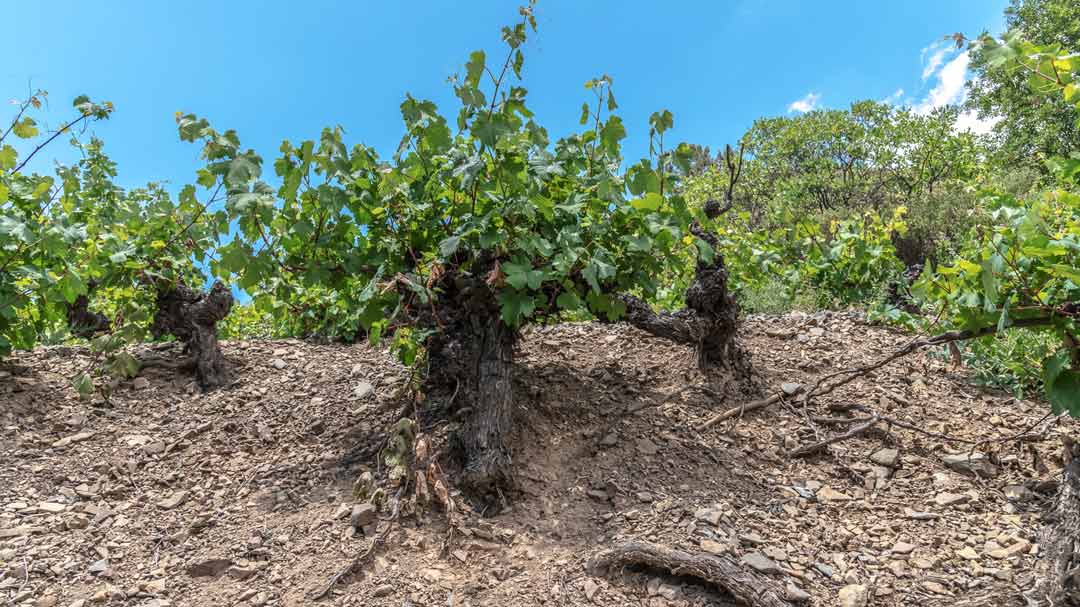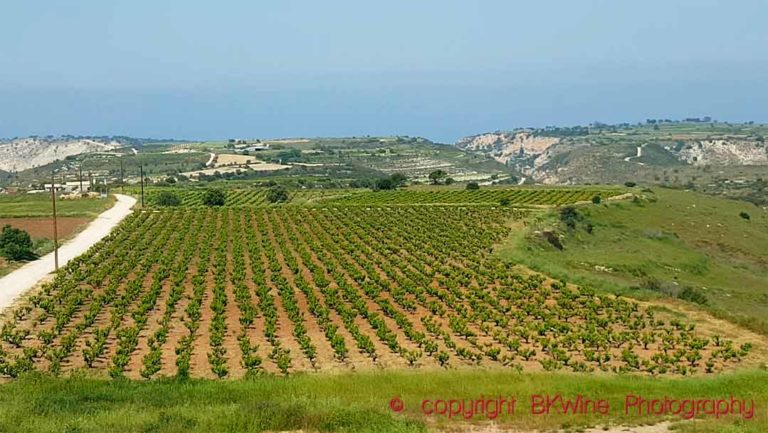Seven years ago, Daniel Anastasis, owner of Santa Irene Winery in Farmakas, and his viticulturist/winemaker, Evangelos Bakalexis, discovered that one of the high-altitude, abandoned vineyards they had taken over from a neighbour was replete with beautiful vines that were between 135 and 150 years old. Most were mavro ambelisimo vines, and the rest were xinisteri, the two most often planted grape varieties in Cyprus since wine was first produced here about 5000 years ago. The two men were thrilled with the discovery and vowed to bring the entire vineyard and its old vines back to productive fruition. They have named the vineyard Vinea Ardua. BKWine Magazine’s guest writer Matthew Stowell gives his personal opinion of the charm and challenges of old vines and one of Cyprus’ most original wines.
But what does “old vines” mean? After a grapevine is first planted, it takes about three years before it produces fruit that can be turned into wine. At seven to eight years old it is considered an ‘adult’, and from 12 to 25 years old it is called ‘mature’. To be designated ‘old’ the vine must be more than 25 years old, preferably more than 50. By then, the vine has very deep roots that extract vital nutrients and moisture from several meters below the ground’s surface.
At present, there is no universally accepted legal definition or classification of old vines except in Barossa Valley, Australia, where they have created the “Old Vine Charter”, in which: Old Vines are 35 years old; Survivor Vines must be 70; Centurian are 100; and Ancestors (such as the Vinea Ardua vines of Santa Irene) are at least 125 years old.
At 400-plus years of age, the oldest living grape vines are in Maribor, Slovenia, and wine is still being produced from their zametovka grapes. Other places with very old vines include: Lodi, California (70 years old); Languedoc, France (300-400 yrs); Barossa Valley, Australia (177-year-old shiraz and grenache); South Africa (120 yrs); and Santorini, Greece where old assyrtiko vines (400 yrs) are used to make Nykteri, which many have described as being favourably comparable to a fine Burgundy.
What’s so special about old vines?
You might ask, “Why would Daniel Anastasis and his winemaker be excited by gnarly, twisted old vines that had suffered through 150 years of intense Mediterranean sun, wind and rain?” Isn’t it better to make wine from fresh, energetic vines pulsing with the vigour of youth? Why do the labels of some of the most expensive wines carry the designation “old vines” as if that’s something to boast about? Doesn’t old mean weak, feeble and close to the end? If we are referring to humans or automobiles the answer is most often yes—but for grape vines it’s an entirely different story.
We know that certain wines, if made correctly and from high-quality grapes, have the ability to dramatically improve with age, but can a 150-year-old vine produce grapes that can be vinified into a superior wine, or are the words “old vines” on the label simply another bit of marketing puffery to justify a higher price?
Suffice it to say that the vine must struggle more to flower into fruit, and although that struggle produces less fruit, all the qualities a winemaker is hoping for are more concentrated in those grapes by the time they are harvested, and they will make a wine that is itself more concentrated, more complex, more powerful and richer in flavour. Think of art that comes after great struggle (Van Gogh, Balzac) and how it endures and is appreciated far beyond what is created by dilettantes.
Old vines are less affected by climate changes, even extreme ones such as drought or floods, and they are less subject to vintage variations: the quality of the fruit is consistent year after year. A major concern for winemakers, when deciding when to harvest the vineyard, is the ripeness of the grapes and the state of the tannins, particularly for red wines. Unripe tannins taste green and bitter. This is not a problem for grapes from old vines as their tannins are more consistent in their ripeness. And wines made from the fruit of old vines have proven to have a greater potential for ageing well.
Do old vines always produce better wines?
Do old vines always produce better wines? Most of the time, yes, but the grape variety of the old vine may have gone out of fashion (petite sirah, trousseau, tannat, claverie, for example), though this is not the case in Cyprus where almost all of its indigenous grapes are celebrated; the mavro ambelisimo grape has been growing in Cyprus for 5,000-6,000 years and is still the most widely planted. And when old vines have been poorly planted (wrong spacing between vines and rows, wrong type of soil), with quantity rather than quality in mind, they will most likely not produce superior wine. But again, this has not been an issue here, and I am confident in saying that in Cyprus the “old vines” moniker constitutes a good thing and is a reliable predictor that you will be enjoying a more tasty wine of noble character. Depending on how old the vines are, you will notice a marked difference in aroma, intricacy, depth and intensity of flavour.
The only real disadvantage to continuing to use old vines is that they produce far fewer grapes than young vines (the old vines of Santa Irene give only 2.5 tons of grapes per hectare against an average of 20-40 tons), so the winemaker must be resigned to having far fewer bottles to sell.
It is possible to make great wine from young vines but it is rare. When it happens, it’s called the “virgin vintage” effect, as exemplified famously by the 1973 Stag’s Leap Cabernet Sauvignon (from three-year-old vines) that won first place against all the Bordeaux entries. But following that virgin vintage, it takes another 10 years from the same vines to achieve a wine of equal quality.
Ancient vines, ancient methods
Santa Irene’s Vinea Ardua (meaning steep or arduously sloped vineyard) comprises 20 hectares of high-altitude, sharply inclined (some at an angle of 60°) hills of old vines that Daniel and his crew have been labouring to make officially organic since 2018. Besides the enormous benefit of the ancient vines, there is an absence on these slope of terracing, a system that can negatively affect drainage and sun exposure. And because there is plenty of morning dew misting across the vineyard, there is no need, or desire, for irrigation.
“To bring good health back to the vines,” says Daniel, “we used special pruning methods that allow the body of the plant to renew itself while continuing to function with the same root system. This took a great deal of time and careful, detailed management. This vineyard, one of highest in Europe, is 1,350 meters above sea level, and its steepness can make for exhausting, sometimes dangerous, labour. We handpick the grapes and clean them, cutting the fruit from the stems, right there in the field.”
Some would say that Daniel is unnecessarily making the whole process even more exhausting by reverting to ancient winemaking methods once the grapes are harvested. He is making three different wines from the Vinea Ardua fields: two mavros (Aepys and Aeoneo) and one xinisteri (Eteon). The xinisteri and one of the mavros are first fermented in pitharia, giant clay jars from the 1800s, that were found in or near Farmakas. No yeast is added, only naturally occurring yeast from the skins is relied upon to turn the grapes into wine. There is a thrice-daily stirring and punching down of the grapes with mankouria (shepherd’s staffs) for six weeks, then a vertical manual press extracts the juice which is transferred to and matured in oak barrels for six to nine months. There is minimal intervention. The wine is not fined or stabilized and it goes into bottles slightly filtered where it rests for another six months. The other mavro, the Aepys, is fermented in stainless steel and oak-barreled for half a year.
“Our winemaking method for these special wines is from the time of Christ,” says Daniel. “It took a lot of hard work to resurrect this Vinea Ardua vineyard. And we are getting only about 20,000 bottles of wine from the 16 hectares (39 acres), but we can now see, and our happy customers can see, that it has been worth it. The wine is truly something special!”
The proof is in the glass
Having sampled the wine onsite and at home, I have to say this is no idle boast. All three wines are nothing short of extraordinary. A friend, who is one of the most discriminating (one might say finicky) wine lovers on the planet, shared a bottle of the Aeoneo with me and was flabbergasted after the first mouthful. She declared it the best Cypriot wine she had ever tasted, and by the end of the session she was fiercely negotiating with me over the last few drops.
The first harvest of the three wines—Eteon (meaning genuine), Aepys (high and steep), and Aeoneo (eternal)—was in 2020 and they are finally available this year.
The xinisteri (its color close to orange) is so rich, so complex for a xinisteri, and so deeply satisfying you might be confused into thinking you are tasting a fine white Bordeaux. It has great body and roundness in the mouth, but at the same time, it is marvelously thirst quenching, as a good tart xinisteri should be.
The steel-fermented mavro, because it is from old vines whose hard-earned energy is concentrated in its sparse grapes, is several cuts above the majority of mavros in Cyprus. It has high character and strength but is extremely smooth on the palate and will enhance any food it accompanies. I would choose it as a quaff for roast chicken or red mullet just as soon as I’d drink it with a steak or with meat meze.
The Aeoneo mavro is in a class by itself. In Cyprus we are lucky to have several world-class red wines from reputable wineries that can now rival the premium wines of France, Italy, Spain and the New World. The Aeoneo, in my opinion, is at the top of that list. From the first sip it elevates you to a loftier plane of oenological pleasure. It’s difficult to believe you are drinking wine made from the until recently much-neglected, much-maligned mavro grape. But the complexity, uplifting energy and lushness of this ancestral-vineyard mavro are qualities usually found only in a prestigeous cabernet sauvignon, a high-end shiraz or an old-style merlot (as in Petrus). I could recommend pairing it with various foods, but in truth I would prefer to enjoy it on its own or at the most with a full-fat cheese and artisanal bread.
Wine from old vines is the purest expression of the vineyard’s terroir. Twisted and gnarled, like the hands of an octogenarian farmer, manifesting decades of weathered life, ancient vines offer some of the most dramatic and unadulterated representations of wine history, tradition and indigenous culture.
Master of Wine, Caroline Gilby, has said about old vines, “. . . because these venerable, gnarly beasts are not easy, nor generous with their yields, they tend to attract a certain kind of producer who is committed to quality above all.”
And there we have a custom-tailored description of Daniel Anastasis and his Vinea Ardua vineyard at Santa Irene, Farmakas.















